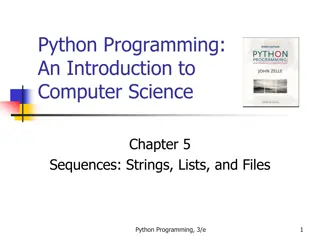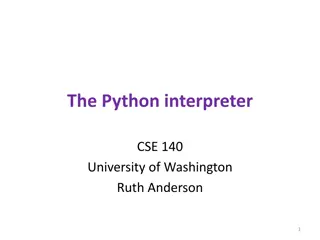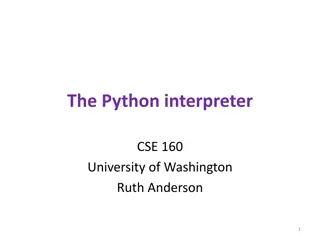Introduction to Python Programming at N.S.S. College: A Brief Overview
Python is a high-level programming language known for being open-source and community-driven. Developed by Guido van Rossum in the late 1980s, Python has evolved over the years to become a versatile language with a rich history. This overview touches upon Python's key features, timeline/history, and interfaces like IDLE. It provides insights into the language's evolution, making it accessible for beginners and enthusiasts alike.
Download Presentation

Please find below an Image/Link to download the presentation.
The content on the website is provided AS IS for your information and personal use only. It may not be sold, licensed, or shared on other websites without obtaining consent from the author. Download presentation by click this link. If you encounter any issues during the download, it is possible that the publisher has removed the file from their server.
E N D
Presentation Transcript
Introduction to Python Programming Dr. C S Prasanth Assistant Professor PG Department of Physics N S S College Pandalam 21JUN19
What is Python? Python is a high-level programming language Open source and community driven Batteries Included a standard distribution includes many modules Dynamic typed Source can be compiled or run just-in-time
4 CS 331 7/29/2024 python Timeline/History Python was conceived in the late 1980s. Guido van Rossum, Benevolent Dictator For Life Rossum is Dutch, born in Netherlands, Christmas break bored, big fan of Monty python s Flying Circus In 1991 python 0.9.0 was published and reached the masses through alt.sources In January of 1994 python 1.0 was released Functional programming tools like lambda, map, filter, and reduce comp.lang.python formed, greatly increasing python s userbase
5 CS 331 7/29/2024 python Timeline/History In 1995, python 1.2 was released. By version 1.4 python had several new features Keyword arguments (similar to those of common lisp) Built-in support for complex numbers Basic form of data-hiding through name mangling (easily bypassed however) Computer Programming for Everybody (CP4E) initiative Make programming accessible to more people, with basic literacy similar to those required for English and math skills for some jobs. Project was funded by DARPA CP4E was inactive as of 2007, not so much a concern to get employees programming literate
6 CS 331 7/29/2024 python Timeline/History In 2000, Python 2.0 was released. Introduced list comprehensions similar to Haskells Introduced garbage collection In 2001, Python 2.2 was released. Included unification of types and classes into one hierarchy, making pythons object model purely Object-oriented Generators were added(function-like iterator behavior)
Python Interfaces IDLE a cross-platform Python development environment PythonWin a Windows only interface to Python Python Shell running 'python' from the Command Line opens this interactive shell
IDLE Development Environment IDLE helps you program in Python by: color-coding your program code debugging auto-indent interactive shell
Example Python Hello World print hello world Prints hello world to standard out Open IDLE and try it out yourself Follow along using IDLE
10 Programming basics code or source code: The sequence of instructions in a program. syntax: The set of legal structures and commands that can be used in a particular programming language. output: The messages printed to the user by a program. console: The text box onto which output is printed. Some source code editors pop up the console as an external window, and others contain their own console window.
Compiling and interpreting Many languages require you to compile (translate) your program into a form that the machine understands. compile execute source code Hello.java byte code Hello.class output Python is instead directly interpreted into machine instructions. interpret source code Hello.py output
12 Real numbers Python can also manipulate real numbers. Examples: 6.022 -15.9997 42.0 2.143e17 The operators + - * / % ** ( ) all work for real numbers. The / produces an exact answer: 15.0 / 2.0 is 7.5 The same rules of precedence also apply to real numbers: Evaluate ( ) before * / % before + - When integers and reals are mixed, the result is a real number. Example: 1 / 2.0 is 0.5 The conversion occurs on a per-operator basis. 7 / 3 * 1.2 + 3 / 2 2 * 1.2 + 3 / 2 2.4 + 3 / 2 2.4 + 1 3.4
Math commands Python has useful commands for performing calculations. 13 Command name abs(value) ceil(value) cos(value) floor(value) log(value) log10(value) max(value1,value2) min(value1,value2) round(value) sin(value) sqrt(value) Description absolute value rounds up cosine, in radians rounds down logarithm, base e logarithm, base 10 larger of two values smaller of two values nearest whole number sine, in radians square root Constant Description 2.7182818... e 3.1415926... pi To use many of these commands, you must write the following at the top of your Python program: from math import *
14 Variables variable: A named piece of memory that can store a value. Usage: Compute an expression's result, store that result into a variable, and use that variable later in the program. assignment statement: Stores a value into a variable. Syntax: name = value A variable that has been given a value can be used in expressions.
print 15 print : Produces text output on the console. Syntax: print "Message" print Expression Prints the given text message or expression value on the console, and moves the cursor down to the next line. print Item1, Item2, ..., ItemN Prints several messages and/or expressions on the same line. Examples: print "Hello, world!" age = 45 print "You have", 65 - age, "years until retirement" Output: Hello, world! You have 20 years until retirement
More than just printing Python is an object oriented language Practically everything can be treated as an object hello world is a string Strings, as objects, have methods that return the result of a function on the string
String Methods Assign a string to a variable In this case hw hw.title() hw.upper() hw.isdigit() hw.islower()
String Methods The string held in your variable remains the same The method returns an altered string Changing the variable requires reassignment hw = hw.upper() hwnow equals HELLO WORLD
input 19 input : Reads a number from user input. You can assign (store) the result of input into a variable. Example: age = input("How old are you? ") print "Your age is", age print "You have", 65 - age, "years until retirement" Output: How old are you? 53 Your age is 53 You have 12 years until retirement
Other Python Objects Lists (mutable sets of strings) var = [] # create list var = [ one , 2, three , banana ] Tuples (immutable sets) var = ( one , 2, three , banana ) Dictionaries (associative arrays or hashes ) var = {} # create dictionary var = { lat : 40.20547, lon : -74.76322} var[ lat ] = 40.2054 Each has its own set of methods
Tuples A tuple is a sequence of immutable Python objects., means you cannot update or change the values of tuple elements Tuples are sequences, just like lists. The differences between tuples and lists are, the tuples cannot be changed unlike lists and tuples use parentheses, whereas lists use square brackets. Like string indices, tuple indices start at 0
Accessing Values in Tuples To access values in tuple, use the square brackets for slicing along with the index or indices to obtain value available at that index. For example #!/usr/bin/python tup1 = ('physics', 'chemistry', 1997, 2000); tup2 = (1, 2, 3, 4, 5, 6, 7 ); print "tup1[0]: ", tup1[0]; print "tup2[1:5]: ", tup2[1:5];
Basic Tuples Operations Tuples respond to the + and * operators much like strings; they mean concatenation and repetition here too, except that the result is a new tuple, not a string.
Indentation and Blocks Python uses whitespace and indents to denote blocks of code Lines of code that begin a block end in a colon: Lines within the code block are indented at the same level To end a code block, remove the indentation You'll want blocks of code that run only when certain conditions are met
Repetition (loops) and Selection (if/else) 25
Conditional Branching if and else if variable == condition: #do something based on v == c else: #do something based on v != c elif allows for additional branching if condition: elif another condition: else: #none of the above
27 The for loop for loop: Repeats a set of statements over a group of values. Syntax: for variableName in groupOfValues: statements We indent the statements to be repeated with tabs or spaces. variableName gives a name to each value, so you can refer to it in the statements. groupOfValues can be a range of integers, specified with the range function. for x in range(1, 6): print x, "squared is", x * x Example: 1 squared is 1 2 squared is 4 3 squared is 9 4 squared is 16 5 squared is 25 Output:
28 range The range function specifies a range of integers: range(start, stop) It can also accept a third value specifying the change between values. range(start, stop, step) - the integers between start (inclusive) Example: for x in range(5, 0, -1): print x Output: 5 4 3 2 1 - the integers between start (inclusive) and stop (exclusive) and stop (exclusive) by step
29 Cumulative loops Some loops incrementally compute a value that is initialized outside the loop. This is sometimes called a cumulative sum. sum = 0 for i in range(1, 11): sum = sum + (i * i) print "sum of first 10 squares is", sum Output: sum of first 10 squares is 385
Looping with For For allows you to loop over a block of code a set number of times For is great for manipulating lists: a = ['cat', 'window', 'defenestrate'] for x in a: print x, len(x) Results: cat 3 window 6 defenestrate 12
Looping with For We could use a for loop to perform geoprocessing tasks on each layer in a list We could get a list of features in a feature class and loop over each, checking attributes Anything in a sequence or list can be used in a For loop Just be sure not to modify the list while looping
32 if if statement: Executes a group of statements only if a certain condition is true. Otherwise, the statements are skipped. Syntax: if condition: statements Example: gpa = 3.4 if gpa > 2.0: print "Your application is accepted."
33 while while loop: Executes a group of statements as long as a condition is True. good for indefinite loops (repeat an unknown number of times) Syntax: while condition: statements Example: number = 1 while number < 200: print number, number = number * 2 Output: 1 2 4 8 16 32 64 128
34 Logic Many logical expressions use relational operators: Operator Meaning Example Result equals does not equal less than greater than less than or equal to greater than or equal to == 1 + 1 == 2 True != 3.2 != 2.5 True < 10 < 5 False > 10 > 5 True <= 126 <= 100 False >= 5.0 >= 5.0 True Logical expressions can be combined with logical operators: Operator Example Result and 9 != 6 and 2 < 3 True or 2 == 3 or -1 < 5 True not not 7 > 0 False
Modules Modules are additional pieces of code that further extend Python s functionality A module typically has a specific function additional math functions, databases, network Python comes with many useful modules arcgisscripting is the module we will use to load ArcGIS toolbox functions into Python
Modules Modules are accessed using import import sys, os # imports two modules Modules can have subsets of functions os.path is a subset within os Modules are then addressed by modulename.function() sys.argv # list of arguments filename = os.path.splitext("points.txt") filename[1] # equals ".txt"
Files Files are manipulated by creating a file object f = open("points.txt", "r") The file object then has new methods print f.readline() # prints line from file Files can be accessed to read or write f = open("output.txt", "w") f.write("Important Output!") Files are iterable objects, like lists
39 Strings string: A sequence of text characters in a program. Strings start and end with quotation mark " or apostrophe ' characters. Examples: "hello" "This is a string" "This, too, is a string. It can be very long!" A string may not span across multiple lines or contain a " character. "This is not a legal String." "This is not a "legal" String either." A string can represent characters by preceding them with a backslash. \t tab character \n new line character \" quotation mark character \\ backslash character Example: "Hello\tthere\nHow are you?"
40 Indexes Characters in a string are numbered with indexes starting at 0: Example: name = "P. Diddy" index 0 1 2 3 4 5 6 7 character P . D i d d y Accessing an individual character of a string: variableName[index] Example: print name, "starts with", name[0] Output: P. Diddy starts with P
41 String properties len(string) string str.lower(string) a string str.upper(string) a string - number of characters in a (including spaces) - lowercase version of - uppercase version of
42 File processing Many programs handle data, which often comes from files. Reading the entire contents of a file: variableName = open("filename").read() Example: file_text = open("bankaccount.txt").read()

 undefined
undefined
















































